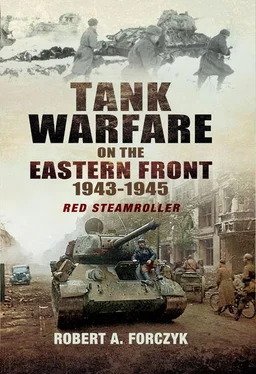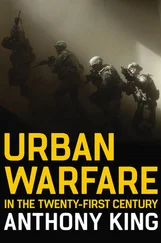However, Fäckenstedt failed in his mission to contain 11 GA’s breakthrough and Bagramyan’s assault troops tore a wide gap in the LIII Armeekorps front near Ulyanovo on 13 July. Satisfied that he had achieved a tactical breakthrough (e.g. the enemy’s front line was torn asunder, but no penetration in depth yet), Bagramyan committed his exploitation force into the gap: General-major Vasily V. Butkov’s 1st Tank Corps (1TC) and General-major Mikhail G. Sakhno’s 5th Tank Corps (5 TC). This mass of Soviet armour advanced southward, past the ineffectual 5.Panzer-Division, slaughtering rear-area units in their path. The only thing that saved the Germans from complete disaster was that the breakthrough occurred in a remote area that was heavily wooded and the only roads were forest trails. The terrain slowed Bagramyan’s breakthrough just enough for Model to pivot his attention and dispatch the 12., 18. and 20.Panzer-Division toward Ulyanovo. Schlieben’s 20.Panzer-Division was the first to encounter Bagramyan’s advancing armour on 14 July, but opted to conduct a mobile delay against Sakhno’s 5TC, rather than launch a hasty counter-attack. Like Fäckenstedt, Schlieben was no Rommel. Nor was the Luftwaffe able to help much initially, since Luftflotte 6 was now engaged against three Soviet air armies and was unable to maintain air superiority over multiple sectors. Fuel shortages also began to impact Luftwaffe operations at this critical moment. When Luftflotte 6 tried to slow Bagramyan’s advance, Soviet fighters from 1VA shot down five Bf-110 fighter-bombers and 15 bombers – this was definitely not the kind of warfare that the Wehrmacht was accustomed to in Russia. {134}
As if Model did not already have his hands full fending off both the Western and Bryansk Front attacks, Rokossovsky’s Central Front joined Operation Kutusov on the morning of 15 July by attacking AOK 9’s salient near Teploye. Major Sauvant’s Tigers occupied excellent overwatch positions on high ground and they proved a formidable obstacle to the Soviet 16th and 19th Tank Corps. Over the course of 15–17 July, Sauvant’s 16–20 Tigers knocked out 54 Soviet tanks at the cost of only two Tigers destroyed. {135} Nevertheless, Model could not hold off three Soviet fronts indefinitely, even by shuffling his Panzer-Divisionen around the perimeter of the shrinking Orel salient. Instead, Model opted on 16 July to pull AOK 9 back to its original start line for Zitadelle and leave just 4.Panzer-Division and Sauvant’s Tigers to hold off Rokossovsky, while he shifted the rest of his armour to deal with Popov and Bagramyan. Model sent Harpe to lead the effort to contain Bagramyan’s breakthrough. Luftflotte 6 also received significant reinforcements, including Hans-Ulrich Rudel’s anti-tank Stukas from III./StG 2 and Hauptmann Erich Hartmann’s III./JG 52. {136} Harpe used the 18. and 20.Panzer-Division to block Sakhno’s 5 TC while Luftflotte 6 tried to gain air superiority from 1 VA, but failed. Luftwaffe aircraft losses over the Orel salient mounted rapidly and Luftflotte 6 was unable to give Model the amount of air support needed to mount successful counter-attacks on the ground. Rudel was shot down (but survived) and even Erich Hartmann’s elite Jagdgruppe had its hands full with 1 VA’s more numerous fighters. {137} Bagramyan continued to advance, but Zhukov denied him further reinforcements for the moment and demanded that he push east toward Bolkhov rather than south to cut off the Orel salient. Zhukov was apparently worried about pushing too much armour off into a void when he knew that Model still had powerful mobile reserves and he decided to reign Bagramyan in and conduct Kutusov in an orthodox, set-piece style rather than as a bold battle of manoeuvre. Zhukov had been defeated by Model in the Rzhev salient only seven months prior and now decided to play it safe – which saved Model’s two armies from encirclement.
In the past, the Soviets had been unable to get three Fronts to work simultaneously against a single German army, but now the operational-level efficiency of the Red Army had increased to the point where coordinated action was achieved and the Germans were being pounded from all directions. Soviet artillery was particularly dominant, gradually wearing down every German front-line position. Faced with a deteriorating situation, Model opted to conduct spoiling attacks with his panzers to knock the Soviets off balance. On 17 July, 2. and 8.Panzer-Divisionen mounted a sharp counter-attack against Panov’s 1 GTC that knocked out 25 tanks. However, Rendulic’s XXXV Armeekorps was gradually being worn down by continuous infantry and artillery attacks from Popov’s 3rd and 63rd Armies, forcing it back toward Orel. Model authorized Rendulic to conduct tactical withdrawals as needed, without the permission of either Hitler or the OKH. By the time that Zhukov finally allowed Rybalko’s rebuilt 3rd Guards Tank Army (3 GTA) to be committed on Popov’s Front on 19 July, Rendulic had already pulled back to shorten his lines and the Soviet armoured fist hit empty positions.
By 20 July, Harpe had stabilized the situation in the north and reduced Bagramyan’s advance to a crawl. The OKH transferred several infantry divisions to rebuild the gap where the LIII Armeekorps had been and Model successfully lobbied for the Großdeutschland to be transferred to him from von Manstein’s front. Bagramyan’s 11 GA had also outrun its supplies. However, Popov’s Bryansk Front was still in good supply since it had two functioning railheads nearby and Popov decided to use Rybalko’s 3 GTA to break open Rendulic’s increasingly thin frontline. Yet instead of using the armour in mass, Popov made the mistake of ordering Rybalko to split his armour and advancing on two divergent axes: the 15th Tank Corps and 2nd Mechanized Corps would proceed northwest to cut the rail line at Otrada while the 12th Tank Corps would advance southwest to overrun one of Rendulic’s infantry divisions. The result of this dispersal was that the Soviet armour gained ground and knocked the German front line back toward Orel, but 3 GTA failed to encircle or destroy any German units. Instead, the Germans hunkered down with 12.Panzer-Division blocking Rybalko’s 3 GTA from entering Orel. In the north, Harpe conducted a strong defence around Bolkhov and the Western Front opted to fight an extended positional battle for this unimportant town rather than using its mobility to outflank Harpe’s Panzers. For nearly a week, Model’s hard-pressed troops fought all three Soviet fronts to a near standstill. However, the cost was high in terms of resources and the Ferdinands, which had proved themselves as excellent defensive weapons, were almost all non-operational now due to mechanical defects and lack of spare parts. {138}
It was not until 26 July that the Soviets were able to make any progress. Rybalko’s 3 GTA shifted south and reinforced an attack by 63rd Army against the boundary between the XXXV Armeekorps and XXXXVI Panzerkorps. Although Rybalko’s armour was unable to break through, when Rokossovsky committed his forces to this axis as well, the Germans gradually began pulling back. German anti-tank fire devastated Rybalko’s armour, knocking out 669 of his tanks in a week of combat. In the north, Zhukov finally released Badanov’s 4th Guards Tank Army (4 GTA) and Kriukov’s 2nd Guards Cavalry Corps (2 GCC) to reinforce the Western Front’s offensive, but achieved only modest results. The Großdeutschland arrived just in the nick of time to block Kriukov’s cavalry from severing the Orel-Bryansk rail line and 4 GTA only managed to force Harpe to abandon Bolkhov. {139} Model did the best he could to delay the inevitable and inflict maximum damage on the enemy, while conserving his own forces, but on 31 July he requested and received permission from Hitler to abandon Orel and retreat to the Hagen Stellung. Unlike von Manstein, Model had developed a contingency plan and had carefully prepared a rearward defensive line along the Desna River.
Читать дальше








![John Stieber - Against the Odds - Survival on the Russian Front 1944-1945 [2nd Edition]](/books/405234/john-stieber-against-the-odds-survival-on-the-russian-front-1944-1945-2nd-edition-thumb.webp)



